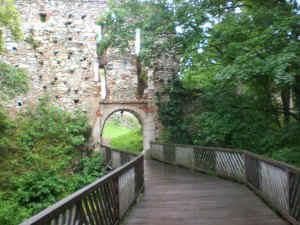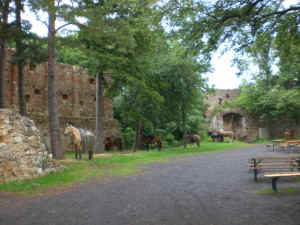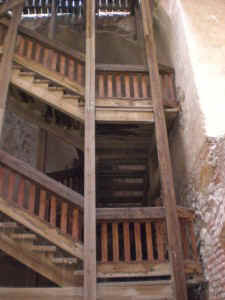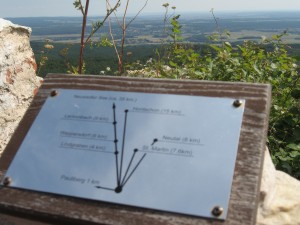|
 The Göttweig
monastery's records of the year 1158 mention a "Gotscalcus de Landeshere." The first castle was erected probably
somewhat earlier to protect an important road. The Landsees were ministers of the Earls of Pitten and presumably
kinsman of the Stubenberger family from Styria. The castle became a possession of the Hungarian Crown by 1222. It
was the western outpost of the county of Lutzmannsburg and part of the line of castles which was to protect the
western border of Hungary. King Béla IV passed it to his cupbearer Conrad who, however, changed allegiance and
became a follower of the Bohemian King, Przemysl Ottokar II. Therefore, in 1263, Landsee was handed over to his
Steward and Gespan (a medieval chieftain in the west and south Slavic region) of Ödenburg, Laurentius Aba, whose
successors were followers of the Earls of Güssing. And so Landsee was one of the castles that were conquered by
Duke Albrecht in the course of the feud of Güssing in 1289. The Göttweig
monastery's records of the year 1158 mention a "Gotscalcus de Landeshere." The first castle was erected probably
somewhat earlier to protect an important road. The Landsees were ministers of the Earls of Pitten and presumably
kinsman of the Stubenberger family from Styria. The castle became a possession of the Hungarian Crown by 1222. It
was the western outpost of the county of Lutzmannsburg and part of the line of castles which was to protect the
western border of Hungary. King Béla IV passed it to his cupbearer Conrad who, however, changed allegiance and
became a follower of the Bohemian King, Przemysl Ottokar II. Therefore, in 1263, Landsee was handed over to his
Steward and Gespan (a medieval chieftain in the west and south Slavic region) of Ödenburg, Laurentius Aba, whose
successors were followers of the Earls of Güssing. And so Landsee was one of the castles that were conquered by
Duke Albrecht in the course of the feud of Güssing in 1289.
 But, following the Peace of Hainburg, the
command over the castle was restored to the King of Hungary. Then the Athinais of the family of the Aba were in
possession of Landsee but, at the end of the 14th century, it passed to the Earls of Mattersdorf-Forchtenstein.
Wilhelm of Forchtenstein, the last of his family, pawned his properties to the Habsburger Albrecht VI, who bought
Landsee in 1447 and passed it on to his brother, Emperor Friedrich III. In 1459, the dominion fell into the hands
of the Hungarian King, Matthias Corvinus. In 1482, he endowed with the dominion Ulrich von Grafeneck, who,
however, is recorded as owner already in the year 1475. It was him who ordered the late Gothic-styled upgrading of
the stronghold. In 1506, Ulrich von Weisspriach, who also was Lord of Kobersdorf, became fief-holder in Landsee.
His possessions were located around Ödenburg (Sopron), which constantly led to conflicts. In the following
"Landsee-feud," his widow hired several groups of mercenaries, including the bandit leader Franz Magutsch, to
harass the city. Finally the bandits were caught and Gertrud von Weisspriach died in jail in 1523. But, following the Peace of Hainburg, the
command over the castle was restored to the King of Hungary. Then the Athinais of the family of the Aba were in
possession of Landsee but, at the end of the 14th century, it passed to the Earls of Mattersdorf-Forchtenstein.
Wilhelm of Forchtenstein, the last of his family, pawned his properties to the Habsburger Albrecht VI, who bought
Landsee in 1447 and passed it on to his brother, Emperor Friedrich III. In 1459, the dominion fell into the hands
of the Hungarian King, Matthias Corvinus. In 1482, he endowed with the dominion Ulrich von Grafeneck, who,
however, is recorded as owner already in the year 1475. It was him who ordered the late Gothic-styled upgrading of
the stronghold. In 1506, Ulrich von Weisspriach, who also was Lord of Kobersdorf, became fief-holder in Landsee.
His possessions were located around Ödenburg (Sopron), which constantly led to conflicts. In the following
"Landsee-feud," his widow hired several groups of mercenaries, including the bandit leader Franz Magutsch, to
harass the city. Finally the bandits were caught and Gertrud von Weisspriach died in jail in 1523.
In 1548, her son Hans handed Landsee to his brother-in-law, the imperial councilor and Gespan Erasmus Teufel. But
Teufel was caught and executed in Istanbul by the Turkish and the archbishop of Gran (Esztergom), Nikolaus Oláh,
bought the dominion of Landsee. In 1561, he handed it over to his nephew, Nikolaus Császár, whose son-in-law
started the expansion of the castle into a mighty fortress shortly before 1600. When his daughter, Ursula, married
Nikolaus Esterházy in 1612, Landsee became the possession of that family, who still own it today.
 The castle was further extended according to
the advanced war engineering of the time. During the wars against the Turkish, it was used as a sanctuary for the
people and as an arsenal for Esterházy's troops but it was never seriously besieged. In 1707, some of the
buildings were severely damaged by a blaze and a gunpowder explosion. After the Turkish were driven out of Central
Europe through the victories of Prince Eugen, Landsee lost its military significance. The arms and other military
equipment were brought to Forchtenstein. In 1772 and 1790, there were additional blazes and the administration of
the dominion was moved to Lackenbach; the complex was abandoned. The surrounding population used its walls as a
welcome stone quarry for building their houses. In 1950, renovation was started by a local beautification society.
The final restoration of the stronghold was accomplished in the course of an EU project in 1998. Over the past
years, theatrics had been organized in the castle's bailey. The castle was further extended according to
the advanced war engineering of the time. During the wars against the Turkish, it was used as a sanctuary for the
people and as an arsenal for Esterházy's troops but it was never seriously besieged. In 1707, some of the
buildings were severely damaged by a blaze and a gunpowder explosion. After the Turkish were driven out of Central
Europe through the victories of Prince Eugen, Landsee lost its military significance. The arms and other military
equipment were brought to Forchtenstein. In 1772 and 1790, there were additional blazes and the administration of
the dominion was moved to Lackenbach; the complex was abandoned. The surrounding population used its walls as a
welcome stone quarry for building their houses. In 1950, renovation was started by a local beautification society.
The final restoration of the stronghold was accomplished in the course of an EU project in 1998. Over the past
years, theatrics had been organized in the castle's bailey.
 Landsee is one of the biggest castle ruins in
Europe. It lies on a dominant location above the Stooberbach valley. The actual stronghold is surrounded by four
circular fortification walls. The outer wall is 1700 meters long and fortified by ten small bastions. For the
protection of the first gate, which is dated 1668, is a two-story bastion containing a guardroom. Crossing a
bridge supported by piles, you reach the second gate, above which there is a broad machicoulis. Originally, a
drawbridge used to be in front of it. The gate structure reaches far into the moat, so that it was possible to
take the second defensive wall (a high earth wall bearing a palisade) under fire from there. This wall was erected
around 1600 to protect the third wall from direct artillery fire. Its gate is protected by a tower and guardroom
as well. The approximately 20 meters-broad moat is spanned by another wooden bridge. In front of the next gate was
a counterpoise bridge. It was decorated by the coat of arms of the Weisspriach family. Landsee is one of the biggest castle ruins in
Europe. It lies on a dominant location above the Stooberbach valley. The actual stronghold is surrounded by four
circular fortification walls. The outer wall is 1700 meters long and fortified by ten small bastions. For the
protection of the first gate, which is dated 1668, is a two-story bastion containing a guardroom. Crossing a
bridge supported by piles, you reach the second gate, above which there is a broad machicoulis. Originally, a
drawbridge used to be in front of it. The gate structure reaches far into the moat, so that it was possible to
take the second defensive wall (a high earth wall bearing a palisade) under fire from there. This wall was erected
around 1600 to protect the third wall from direct artillery fire. Its gate is protected by a tower and guardroom
as well. The approximately 20 meters-broad moat is spanned by another wooden bridge. In front of the next gate was
a counterpoise bridge. It was decorated by the coat of arms of the Weisspriach family.
Now you get into the extensive outer bailey. Its left side is bordered by a mighty frontal wall, while on the
right lie the ruins of several farm buildings and barracks. Their external walls are provided with embrasures, so
that they can be used for defense as well. At the end of the bailey, a stair tower leads to a higher-seated inner
bailey, where the accommodations and kitchens were. A beautiful Renaissance gate finally leads to the actual
living quarters. Here, around a triangular bailey, were representative rooms equipped by Pietro Antonio Conti in
the 17th century. Through a Gothic tower, heightened in the baroque period, you get into the medieval part of the
castle, which mainly dates from the late 15th century.
 From a small bailey, via
wooden corridors and stairways, you could once get into the several rooms. Still today, they show relics of Gothic
door and window carpeting, fireplaces and arches. The Romanic donjon forms the core of the stronghold and was
built on the highest point of the quartzite rock. Later, its exposed western side was fortified and reached the
10-meter wall thickness of today. The tower is crowned by a characteristic wall arch, the relic of a former
cupola. From a small bailey, via
wooden corridors and stairways, you could once get into the several rooms. Still today, they show relics of Gothic
door and window carpeting, fireplaces and arches. The Romanic donjon forms the core of the stronghold and was
built on the highest point of the quartzite rock. Later, its exposed western side was fortified and reached the
10-meter wall thickness of today. The tower is crowned by a characteristic wall arch, the relic of a former
cupola.
A walk around the Castle Ruins
of Landsee
Visitation from the beginning of April to the end of October, daily from 9
am to 6 pm, or until nightfall.
Guided tours on appointment, for information and registration contact:
Elisabeth Schütz
Hauptstraße 88
A-7341 Landsee
Phone: +43 2618 / 7306
Mobile: + 43 664 / 798 13 16
|

 The Göttweig
monastery's records of the year 1158 mention a "Gotscalcus de Landeshere." The first castle was erected probably
somewhat earlier to protect an important road. The Landsees were ministers of the Earls of Pitten and presumably
kinsman of the Stubenberger family from Styria. The castle became a possession of the Hungarian Crown by 1222. It
was the western outpost of the county of Lutzmannsburg and part of the line of castles which was to protect the
western border of Hungary. King Béla IV passed it to his cupbearer Conrad who, however, changed allegiance and
became a follower of the Bohemian King, Przemysl Ottokar II. Therefore, in 1263, Landsee was handed over to his
Steward and Gespan (a medieval chieftain in the west and south Slavic region) of Ödenburg, Laurentius Aba, whose
successors were followers of the Earls of Güssing. And so Landsee was one of the castles that were conquered by
Duke Albrecht in the course of the feud of Güssing in 1289.
The Göttweig
monastery's records of the year 1158 mention a "Gotscalcus de Landeshere." The first castle was erected probably
somewhat earlier to protect an important road. The Landsees were ministers of the Earls of Pitten and presumably
kinsman of the Stubenberger family from Styria. The castle became a possession of the Hungarian Crown by 1222. It
was the western outpost of the county of Lutzmannsburg and part of the line of castles which was to protect the
western border of Hungary. King Béla IV passed it to his cupbearer Conrad who, however, changed allegiance and
became a follower of the Bohemian King, Przemysl Ottokar II. Therefore, in 1263, Landsee was handed over to his
Steward and Gespan (a medieval chieftain in the west and south Slavic region) of Ödenburg, Laurentius Aba, whose
successors were followers of the Earls of Güssing. And so Landsee was one of the castles that were conquered by
Duke Albrecht in the course of the feud of Güssing in 1289. But, following the Peace of Hainburg, the
command over the castle was restored to the King of Hungary. Then the Athinais of the family of the Aba were in
possession of Landsee but, at the end of the 14th century, it passed to the Earls of Mattersdorf-Forchtenstein.
Wilhelm of Forchtenstein, the last of his family, pawned his properties to the Habsburger Albrecht VI, who bought
Landsee in 1447 and passed it on to his brother, Emperor Friedrich III. In 1459, the dominion fell into the hands
of the Hungarian King, Matthias Corvinus. In 1482, he endowed with the dominion Ulrich von Grafeneck, who,
however, is recorded as owner already in the year 1475. It was him who ordered the late Gothic-styled upgrading of
the stronghold. In 1506, Ulrich von Weisspriach, who also was Lord of Kobersdorf, became fief-holder in Landsee.
His possessions were located around Ödenburg (Sopron), which constantly led to conflicts. In the following
"Landsee-feud," his widow hired several groups of mercenaries, including the bandit leader Franz Magutsch, to
harass the city. Finally the bandits were caught and Gertrud von Weisspriach died in jail in 1523.
But, following the Peace of Hainburg, the
command over the castle was restored to the King of Hungary. Then the Athinais of the family of the Aba were in
possession of Landsee but, at the end of the 14th century, it passed to the Earls of Mattersdorf-Forchtenstein.
Wilhelm of Forchtenstein, the last of his family, pawned his properties to the Habsburger Albrecht VI, who bought
Landsee in 1447 and passed it on to his brother, Emperor Friedrich III. In 1459, the dominion fell into the hands
of the Hungarian King, Matthias Corvinus. In 1482, he endowed with the dominion Ulrich von Grafeneck, who,
however, is recorded as owner already in the year 1475. It was him who ordered the late Gothic-styled upgrading of
the stronghold. In 1506, Ulrich von Weisspriach, who also was Lord of Kobersdorf, became fief-holder in Landsee.
His possessions were located around Ödenburg (Sopron), which constantly led to conflicts. In the following
"Landsee-feud," his widow hired several groups of mercenaries, including the bandit leader Franz Magutsch, to
harass the city. Finally the bandits were caught and Gertrud von Weisspriach died in jail in 1523. The castle was further extended according to
the advanced war engineering of the time. During the wars against the Turkish, it was used as a sanctuary for the
people and as an arsenal for Esterházy's troops but it was never seriously besieged. In 1707, some of the
buildings were severely damaged by a blaze and a gunpowder explosion. After the Turkish were driven out of Central
Europe through the victories of Prince Eugen, Landsee lost its military significance. The arms and other military
equipment were brought to Forchtenstein. In 1772 and 1790, there were additional blazes and the administration of
the dominion was moved to Lackenbach; the complex was abandoned. The surrounding population used its walls as a
welcome stone quarry for building their houses. In 1950, renovation was started by a local beautification society.
The final restoration of the stronghold was accomplished in the course of an EU project in 1998. Over the past
years, theatrics had been organized in the castle's bailey.
The castle was further extended according to
the advanced war engineering of the time. During the wars against the Turkish, it was used as a sanctuary for the
people and as an arsenal for Esterházy's troops but it was never seriously besieged. In 1707, some of the
buildings were severely damaged by a blaze and a gunpowder explosion. After the Turkish were driven out of Central
Europe through the victories of Prince Eugen, Landsee lost its military significance. The arms and other military
equipment were brought to Forchtenstein. In 1772 and 1790, there were additional blazes and the administration of
the dominion was moved to Lackenbach; the complex was abandoned. The surrounding population used its walls as a
welcome stone quarry for building their houses. In 1950, renovation was started by a local beautification society.
The final restoration of the stronghold was accomplished in the course of an EU project in 1998. Over the past
years, theatrics had been organized in the castle's bailey. Landsee is one of the biggest castle ruins in
Europe. It lies on a dominant location above the Stooberbach valley. The actual stronghold is surrounded by four
circular fortification walls. The outer wall is 1700 meters long and fortified by ten small bastions. For the
protection of the first gate, which is dated 1668, is a two-story bastion containing a guardroom. Crossing a
bridge supported by piles, you reach the second gate, above which there is a broad machicoulis. Originally, a
drawbridge used to be in front of it. The gate structure reaches far into the moat, so that it was possible to
take the second defensive wall (a high earth wall bearing a palisade) under fire from there. This wall was erected
around 1600 to protect the third wall from direct artillery fire. Its gate is protected by a tower and guardroom
as well. The approximately 20 meters-broad moat is spanned by another wooden bridge. In front of the next gate was
a counterpoise bridge. It was decorated by the coat of arms of the Weisspriach family.
Landsee is one of the biggest castle ruins in
Europe. It lies on a dominant location above the Stooberbach valley. The actual stronghold is surrounded by four
circular fortification walls. The outer wall is 1700 meters long and fortified by ten small bastions. For the
protection of the first gate, which is dated 1668, is a two-story bastion containing a guardroom. Crossing a
bridge supported by piles, you reach the second gate, above which there is a broad machicoulis. Originally, a
drawbridge used to be in front of it. The gate structure reaches far into the moat, so that it was possible to
take the second defensive wall (a high earth wall bearing a palisade) under fire from there. This wall was erected
around 1600 to protect the third wall from direct artillery fire. Its gate is protected by a tower and guardroom
as well. The approximately 20 meters-broad moat is spanned by another wooden bridge. In front of the next gate was
a counterpoise bridge. It was decorated by the coat of arms of the Weisspriach family. From a small bailey, via
wooden corridors and stairways, you could once get into the several rooms. Still today, they show relics of Gothic
door and window carpeting, fireplaces and arches. The Romanic donjon forms the core of the stronghold and was
built on the highest point of the quartzite rock. Later, its exposed western side was fortified and reached the
10-meter wall thickness of today. The tower is crowned by a characteristic wall arch, the relic of a former
cupola.
From a small bailey, via
wooden corridors and stairways, you could once get into the several rooms. Still today, they show relics of Gothic
door and window carpeting, fireplaces and arches. The Romanic donjon forms the core of the stronghold and was
built on the highest point of the quartzite rock. Later, its exposed western side was fortified and reached the
10-meter wall thickness of today. The tower is crowned by a characteristic wall arch, the relic of a former
cupola.